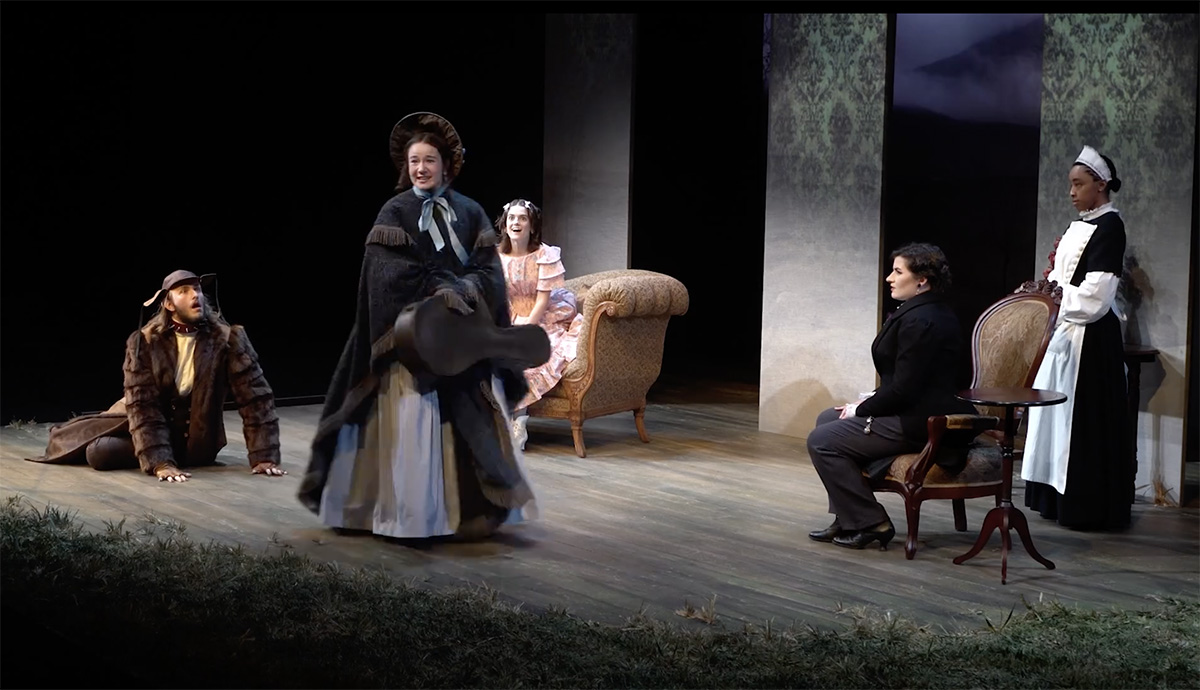A strange, old Victorian house on the edge of the bleak, disorienting moors of Yorkshire… characters that suggest the Brontë sisters and their dissolute brother, Branwell…and, of course, the arrival of a new governess with a past—that is the atmosphere of The Moors, a play by Jen Silverman that opened in Clarence Brown Theatre’s Lab Theatre last weekend. With references to Jane Eyre and Wuthering Heights, one immediately suspects satire. But as the fog rolls across The Moors, we find ourselves knee deep in the marsh of Silverman’s delicious twists and turns of plot that have elements of both horror and comedy.
Directed by Casey Sams, the production is a masterful construction that walks the fine line between satire and imagination, allowing the intriguing narrative to methodically reveal and explain its intentions and surprises in much the same way that horror films use repetition and the “rule of three” to dictate the action. The performances of the cast are immensely impressive; the stagecraft is remarkably effective in enveloping the audience in the essential atmosphere.
With Brontë-like motivations of desperation and suppressed passion, the plot unfolds, albeit mysteriously. A governess, Emilie (Ella Trisler), arrives to join the apparently lonely household of sisters, the dominant Agatha (Catherine Blevins) and the submissive Huldey (Molly Brennan). Emilie has been lured to the position by enticing letters she had received from brother Branwell. Strangely, Branwell seems to be absent when she arrives, as well as any sign of a child needing a governess. The sisters each have unfulfilled needs, but of different kinds. Blevins’ stern and insulting Agatha rules the household, as well as apparently ruling Huldey. Brennan’s energetic and frivolous Huldey is a successful facade for the character’s yearning for recognition and some kind of excitement. Huldey, desperate for companionship, looks to the governess, but Emilie’s attention is diverted when the real author of the letters is revealed, leaving Huldey to wallow in an ever-increasing state of frustration and loneliness.
In a comic twist, another part of the household is/are Marjory and Mallory (the marvelous Jasmine R. Handy), simultaneously—if not surreally—the parlor maid or the scullery maid, who may be pregnant, or otherwise have typhus, caring for rooms that somehow all look alike.

In a bit of ironic whimsy, the house is also occupied by the deep-voiced and darkly philosophical Mastiff (Jackson Ahern), who, like the women, languishes from lack of recognition and love under Agatha’s control, having to accept her cruel description of him as brutal and savage. Venturing onto the moor, he meets a Moor-Hen (perfectly rendered by Abigail McCarter) injured from a crash landing. His desperation leads to their romance, although the inevitable results come as a surprise. It shouldn’t, I guess.
Sopie Smrcka’s set and projections are brilliantly evocative and immersive, including the floor itself which symbolically suggests the moor and its timeless encroachment. Mitch Wilson’s lighting set the narrative mood; Alex Heder’s costumes were marvelous extensions of the characters’ personalities. Sound designer Amoirie Perteet’s environmental effects were both beautifully subtle and—briefly—explosively colorful.
This marvelous production has one downside: the one act running time is approximately 100 minutes. On the other hand, you’ll scarcely notice it. The Moors in the Clarence Brown Lab Theatre continues through Sunday, November 5. Check the website for days, times, tickets, and further information.






